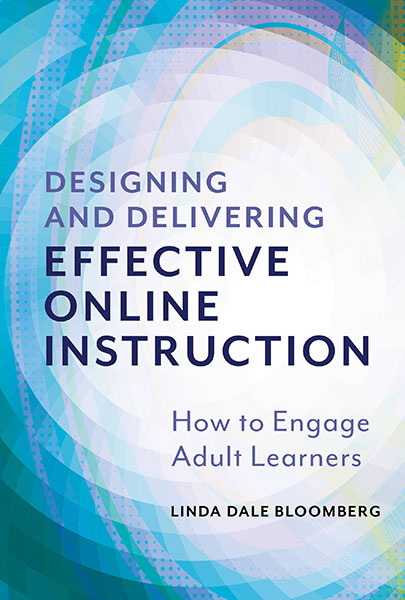 Linda Dale Bloomberg holds the positions of Associate Director of faculty support and development, and full professor of education in the Sanford College of Education, National University. Dr. Bloomberg received her doctorate in 2006 from Teachers College, Columbia University, where she completed the AEGIS Program in Adult and Organizational Learning. Her book is Designing and Delivering Effective Online Instruction: How to Engage Adult Learners.
Linda Dale Bloomberg holds the positions of Associate Director of faculty support and development, and full professor of education in the Sanford College of Education, National University. Dr. Bloomberg received her doctorate in 2006 from Teachers College, Columbia University, where she completed the AEGIS Program in Adult and Organizational Learning. Her book is Designing and Delivering Effective Online Instruction: How to Engage Adult Learners.
In 2021 I published Designing and Delivering Effective Online Instruction: How to Engage Adult Learners, a resource for faculty and course designers seeking to develop more equitable and communal online classroom spaces, thereby providing a way forward in developing online teaching practices. The book includes multiple ideas for creating transformative student-centered teaching and learning experiences with the focus heavily on ensuring equity and inclusion. As I write in the book,
Inclusion represents the extent to which individuals feel valued, respected, encouraged to participate fully, and able to be their authentic selves. Inclusive pedagogy describes curriculum and teaching approaches that encourage learners to have a sense of belongingness… Addressing diversity and inclusion—to support the growth of all learners—is something that should be infused throughout your teaching practice right from design and development of a course, through implementation and assessment. We can work toward a more inclusive educational experience when we take the time to understand our learners’ contexts and their unique needs through the relationships that we build with them. Inclusion is rooted deeply in the democratic principles of both justice and opportunity, and educators have a responsibility to ensure that all learners can fulfill their goals of completion. Toward this end, every learning experience should offer full equity and inclusion for all learners. (Bloomberg, 2021, p. 123)
It is imperative that we implement teaching strategies that promote access, inclusivity, and a sense of belonging for all learners, including those of diverse cultural backgrounds and minority or under-represented groups. Equity implies building a learning environment where all voices are heard, where learners have opportunities to lead and guide discussions as well as advocate for their own needs; thereby providing access to knowledge and strengthening learning. What types of inclusive engagement strategies are YOU facilitating each day?
Engage Through Presence
Research consistently recognizes engagement as one of the most significant factors impacting academic performance and overall achievement; with clear evidence that issue of isolation and disconnection is an essential consideration as this inhibits engagement and learning. Learner engagement and instructor engagement are two sides of the same coin and are essentially reciprocal in nature. Learner engagement ensures ongoing motivation and persistence. Instructor engagement implies the idea of being “present” for your learners, thereby establishing a sense of “teaching presence.”
The concept of presence is a key component of the Community of Inquiry Model developed by Garrison and Cleveland-Innes (2005), which relates to instructors developing collaborative working relationships and interacting with learners in order to bridge the distance and generate greater engagement. As stated by Garrison et al (2007), “Understanding the role of social presence is essential in creating a community of inquiry and in designing, facilitating and directing higher-order learning.” (p. 168). Emotional presence is a more recent addition to the original Community of Inquiry framework, becoming a key driver to online learning; particularly because how learners actually feel has an impact on their motivation, engagement, and academic success (Cleveland-Innes & Campbell, 2012).
Action Item: Don’t underestimate the power of your presence!
Reimagine your role as “teacher” and move toward becoming a proactive and responsive partner in the learning experience by intentionally and thoughtfully developing meaningful and collaborative relationships to best support all of your learners. Remain visible, available, and accessible. Provide multiple regular opportunities for connection and support. Bring your own sense of self and humanity to the learning environment and model what this looks like for your learners. Find ways to make clear what it means to have an authentic presence in the online classroom, and how this is essential to learner engagement, knowledge-building, and understanding.
Support Learner Empowerment
Achieving learner engagement is only one step in supporting learning. Learner empowerment is the ensuing vital step. The goal of education is essentially to meet the needs of all learners, offering them the ownership, agency and autonomy to actively engage in inquiry, so that they are empowered to implement changes in their personal and professional lives, and ultimately in the lives of others. Inquiry, the experience of seeking knowledge and understanding through authentic questions, engages all learners, champions and supports all voices, celebrates learners’ strengths, and promotes ownership of knowledge.
To ensure that all learners embrace learning, be intentional with regard to developing an asset-based approach to teaching and nurturing an empowered mindset. Engendering an empowered mindset applies to all learners and in particular to those who have been historically marginalized and discriminated against by way of race, ethnicity, gender identity, sexual orientation, socioeconomic status, ability, or other realities. The underlying implication lies in empowering all learners to advocate for themselves and receive an education that addresses their unique needs.
Action Item: Draw on resources, materials, and anecdotes that are relevant to the subject matter.
Remain sensitive to the social and cultural diversity of your learners. Take time to attend to each learner and meet them where they are. Include a feedback or student-review component, throughout and/or at the end of a course. Seeking feedback ensures that learners’ perspectives and input are welcomed, heard, and respected. Make sure to address the feedback that you receive and make any needed changes or revisions.
Develop a Learning Community
Learner engagement is not typically an end in itself. We want learners to be engaged because it leads to outcomes that we value such as achievement, satisfaction, increased motivation, and an ongoing sense of belonging. Developing a learning community has been at the heart of distance education since its inception (Garrison et al., 2007), and the need to foster community in the online environment remains a focal issue. Learning is a social activity, and meaningful and purposeful learning occurs through learning with and from each other. Dewey (1938) defined learning in terms of experience, reflection, continuity, and interactivity; all of which constitute a sense of community.
The notion of a learning community is predicated on the value of connection and collaboration among learners and instructors, where interaction and participation are ongoing, regular, and focused around shared values and goals. Collaborative experiences allow learners and instructors to value the other’s perspectives, thereby learning with and from one another. Moreover, learners should not only feel a sense of having learned, but a sense of having created learning for the community they contributed to shaping. Creating strategic opportunities to form meaningful connections contributes to and sustains discourse, which in turn fosters a culture of inclusivity.
Action Item: Intentionally work toward creating a collaborative learning environment.
Create opportunities for authentic human connection that meaningfully foster interest and engagement within a safe and supportive space. Be thoughtful in building interactive opportunities between instructors and learners, learners and peers, and learners and course content. Actively gather feedback that can help create and improve a climate that supports all learners and their “multiple voices”.
Now Is the Time to Put Equity Into Action!
The message throughout my book Designing and Delivering Effective Online Instruction: How to Engage Adult Learners is based on the progressive belief that powerful and meaningful teaching is grounded in inquiry, community, and equity (Dewey, 1938). It is critical that we, as educators, remain consistent in our commitment to creating classrooms as “equitable spaces” that enhance learning. Equity work requires thoughtful, intentional, and sustained efforts to identify and meet the specific needs of diverse groups or individuals. ALL students should have opportunities to benefit from accessible content and opportunities to bring their authentic selves into the classroom and embrace learning by engaging with course materials in ways that will set them up for success.
How do you think about yourself as a truly transformative educator? How do you think about learners as trail blazers, inquirers, and community members? How do you think about learning spaces as placeholders for deep learning and community-building? In the interests of maximizing self-awareness and a commitment to inclusion, how can you welcome, grow, and innovate a way forward to strengthen your practices for the online classroom?
- Take time to reflect deeply on your own background, experiences, and assumptions. This is critical in providing insights into necessary changes that can foster inclusive and equitable teaching practices.
- Reflect on who your learners are, and the contexts, environments, and conditions in which they find themselves. Don’t assume that all learners are in a space that provides them with an ideal learning experience.
- Notice your interactions with students, your tone, the types of examples you use, and the clarity of your explanations. Consider what specific actions stand out, and what impact these might have on your learners.
- After every class make notes about what worked well, what could be improved, and what you could do differently next time. Commit to ongoing improvement by trusting what you notice to inform your course design and instructional approach.
- Ask learners for feedback regarding their learning experiences. Make appropriate changes as needed to create safe and supportive learning spaces that embrace multiple voices!

Designing and Delivering Effective Online Instruction
How to Engage Adult Learners
Linda Dale Bloomberg
Resources
Bloomberg, L. D. (2021). Designing and delivering effective online instruction: How to engage adult learners. Teachers College Press, Columbia University.
This publication was nominated for the 2021 and 2022 Division of Distance Learning (DDL) for the Association of Educational Communications and Technology (AECT).
Cleveland-Innes, M., & Campbell, P. (2012). Emotional presence, learning, and the online learning environment. International Review of Research in Open and Distance Learning, 13(4), 269-292.
Dewey, J. (1938). Experience and education. McMillan
Garrison and Cleveland-Innes (2005). Facilitating cognitive presence in online learning: Interaction is not enough. American Journal of Distance Education 19(3), 133-148.
Garrison, D. R., Anderson, T., & Archer, W. (2007). Researching the community of inquiry framework. Review, issues, and future directions. The Internet and Higher Education, 10(3),17-172.
